Photokina 2012 : Interview de Pentax Ricoh by clover
Pentax K par K :: LES PETIT's + :: NEWS RELATIVES A LA PHOTO :: Logiciels, Optiques compatibles Pentax, Accessoires
Page 3 sur 3 • Partagez
Page 3 sur 3 •  1, 2, 3
1, 2, 3
 Re: Photokina 2012 : Interview de Pentax Ricoh by clover
Re: Photokina 2012 : Interview de Pentax Ricoh by clover
Le 24*36 ne fait pas rêver car je suis refroidi par le prix du boîtier et des optiques, l'encombrement, le poids.
La qualité du capteur du K5 me suffit, les prochains seront probablement mieux, encore plus sensible et un AF plus précis et plus rapide.
Ma priorité est plus tôt d'améliorer ma gamme d'objectifs.
La qualité du capteur du K5 me suffit, les prochains seront probablement mieux, encore plus sensible et un AF plus précis et plus rapide.
Ma priorité est plus tôt d'améliorer ma gamme d'objectifs.
bp30- Dieu Tchatcheur

- Nombre de messages : 7706
Date d'inscription : 29/10/2008
 Re: Photokina 2012 : Interview de Pentax Ricoh by clover
Re: Photokina 2012 : Interview de Pentax Ricoh by clover
[/quote="tiniloulou"] Tu sais quoi? C'est toi qui devient pathétique à faire sans cesse tes remarques acerbes et avec les conseils et leçons que tu prétends donner à tout le monde. Achète toi une boîte de RENNIE et va soigner tes aigreurs ailleurs. Tu dois être un peu maso pour lire toutes ces discussions qui ne t'interessent pas...
C'est pourtant facile, il suffit de ne pas venir sur le forum ou de ne pas cliquer sur les fils que tu n'as pas envie de lire.
Un forum, c'est fait pour discuter.
en informatique, forum (sens provenant du latin et de l'anglais) est un espace virtuel qui permet de discuter librement sur plusieurs sujets divers
Si ça te gonfle, tu fais autre chose. Tu devrais peut-être aussi créer un fil pour nous dire à tous ce que l'on a droit de dire ou ne pas dire et ainsi ne pas heurter ta sensibilité. Ou alors, encore mieux, tu crées ton propre forum et tu fais tes discussions tout seul.
Allez faire des photos, c'est le premier jour de l'automne
Et là, c'est la partie la plus drôle. Le gars qui donne un conseil mais qui ne le mets pas lui-même en pratique. (quand tu écris ça, j'imagine que tu n'es pas en même temps dehors à faire des photos)... [/quote]
(quand tu écris ça, j'imagine que tu n'es pas en même temps dehors à faire des photos)... [/quote]
Je vais juger aussi : ça devient complètement délirant, cette agressivité pour des bouts de plastiques...
C'est pourtant facile, il suffit de ne pas venir sur le forum ou de ne pas cliquer sur les fils que tu n'as pas envie de lire.
Un forum, c'est fait pour discuter.
en informatique, forum (sens provenant du latin et de l'anglais) est un espace virtuel qui permet de discuter librement sur plusieurs sujets divers
Si ça te gonfle, tu fais autre chose. Tu devrais peut-être aussi créer un fil pour nous dire à tous ce que l'on a droit de dire ou ne pas dire et ainsi ne pas heurter ta sensibilité. Ou alors, encore mieux, tu crées ton propre forum et tu fais tes discussions tout seul.
Allez faire des photos, c'est le premier jour de l'automne
Et là, c'est la partie la plus drôle. Le gars qui donne un conseil mais qui ne le mets pas lui-même en pratique.
Je vais juger aussi : ça devient complètement délirant, cette agressivité pour des bouts de plastiques...
Dernière édition par brice 81 le Mer 07 Nov 2012, 00:04, édité 2 fois

brice 81- Maitre Tchatcheur

-
 Nombre de messages : 352
Nombre de messages : 352
Age : 43
Localisation : paris
Date d'inscription : 05/06/2008
 Re: Photokina 2012 : Interview de Pentax Ricoh by clover
Re: Photokina 2012 : Interview de Pentax Ricoh by clover
tiniloulou a écrit:serdeber a écrit:Encore un fil de bla-bla....
Et ça c'est mieux que ci, et ça c'est mieux que ça
Et Pentax va faire ci, et pentax doit faire ça
Et Pentax va p'tet mourir, et Pentax va p'tet réussir
Ca devient pathétique tous ces fils qui se propagent partout sur ce forum, tous ces experts qui savent tout. Au final, on n'en sait pas plus, les jap feront ce qu'ils veulent et ça fout une ambiance bizare pré 21 décembre 2012.
Tu sais quoi? C'est toi qui devient pathétique à faire sans cesse tes remarques acerbes et avec les conseils et leçons que tu prétends donner à tout le monde. Achète toi une boîte de RENNIE et va soigner tes aigreurs ailleurs. Tu dois être un peu maso pour lire toutes ces discussions qui ne t'interessent pas...
C'est pourtant facile, il suffit de ne pas venir sur le forum ou de ne pas cliquer sur les fils que tu n'as pas envie de lire.
Un forum, c'est fait pour discuter.en informatique, forum (sens provenant du latin et de l'anglais) est un espace virtuel qui permet de discuter librement sur plusieurs sujets divers ;
Si ça te gonfle, tu fais autre chose. Tu devrais peut-être aussi créer un fil pour nous dire à tous ce que l'on a droit de dire ou ne pas dire et ainsi ne pas heurter ta sensibilité. Ou alors, encore mieux, tu crées ton propre forum et tu fais tes discussions tout seul.Allez faire des photos, c'est le premier jour de l'automne
Et là, c'est la partie la plus drôle. Le gars qui donne un conseil mais qui ne le mets pas lui-même en pratique.(quand tu écris ça, j'imagine que tu n'es pas en même temps dehors à faire des photos)...
On se demande qui a besoin de soigner ses aigreurs...
T'as donné ton avis, moi j'ai donné le mien. Et vous polluez les fils avec vos analyses bidons que vous rabâchez sans cesse. Je vois le titre d'un fil qui m’intéresse, je lis. Et je tombe sur les mêmes rengaines.
Et à 12h30, je prend l'apéro, je ne fais pas de photos
Dernière édition par serdeber le Sam 22 Sep 2012, 23:53, édité 1 fois
 Re: Photokina 2012 : Interview de Pentax Ricoh by clover
Re: Photokina 2012 : Interview de Pentax Ricoh by clover
Il y a trop de demandes, de souhaits ou d'exigences de la part des Pentaxonautes. On peut rêver de tout mais la stratégie de Pentax ne peut pas répondre à tous les besoins. D'ailleurs aucune marque ne le peut.
Elle choisit une voie et la seule chose qu'on peut lui espérer est qu'elle parvienne à bien se relancer. Quittez une marque pour une autre n'est pas la fin du monde, plusieurs photographes le font.
Dans mon propre cas, tant qu'il existera des APS-C Pentax à moins de 1000$ aussi performants que ses concurrents, je resterais chez eux. Le FF ou un APS-C a plus de 1500$ ne m'intéresse pas. Tant mieux s'ils en sortent un, mais je ne serais pas l'acquéreur de ce genre de réflex.
La seule raison qui me ferait réellement partir serait le manque d'objectifs compatibles pour mes besoins propres. Mais là encore, je ne mettrais pas plus de 1000$ pour un objectif.
En tant que client, c'est cette limite budgétaire qui me définit. Et si je ne vais pas chez Canon et Nikon, c'est parce qu'à modèle équivalent (Réflex / Objectifs), ils sont généralement moins intéressants. Maintenant, ces 2 marques changeraient de créneau marketing pour répondre à mes besoins propres, et bien, oui, j'achèterais chez eux.
Rien de plus simple.
Elle choisit une voie et la seule chose qu'on peut lui espérer est qu'elle parvienne à bien se relancer. Quittez une marque pour une autre n'est pas la fin du monde, plusieurs photographes le font.
Dans mon propre cas, tant qu'il existera des APS-C Pentax à moins de 1000$ aussi performants que ses concurrents, je resterais chez eux. Le FF ou un APS-C a plus de 1500$ ne m'intéresse pas. Tant mieux s'ils en sortent un, mais je ne serais pas l'acquéreur de ce genre de réflex.
La seule raison qui me ferait réellement partir serait le manque d'objectifs compatibles pour mes besoins propres. Mais là encore, je ne mettrais pas plus de 1000$ pour un objectif.
En tant que client, c'est cette limite budgétaire qui me définit. Et si je ne vais pas chez Canon et Nikon, c'est parce qu'à modèle équivalent (Réflex / Objectifs), ils sont généralement moins intéressants. Maintenant, ces 2 marques changeraient de créneau marketing pour répondre à mes besoins propres, et bien, oui, j'achèterais chez eux.
Rien de plus simple.
 Re: Photokina 2012 : Interview de Pentax Ricoh by clover
Re: Photokina 2012 : Interview de Pentax Ricoh by clover
Juste une remarque :
L'idée de l'interview m'était venue car je trouvais dommage de ne pas avoir des infos officielles pour calmer un peu les rumeurs trop débordantes ( que moi même j'ai dû croire pour certaines ).
Au final, cela n'empêche pas forcément ceux de ne pas y croire et ceux qui veulent y croire, voir les interprétations peuvent être contradictoires...
Soupir...
L'idée de l'interview m'était venue car je trouvais dommage de ne pas avoir des infos officielles pour calmer un peu les rumeurs trop débordantes ( que moi même j'ai dû croire pour certaines ).
Au final, cela n'empêche pas forcément ceux de ne pas y croire et ceux qui veulent y croire, voir les interprétations peuvent être contradictoires...
Soupir...

clover- Dieu Tchatcheur

-
 Nombre de messages : 2009
Nombre de messages : 2009
Age : 50
Localisation : Earth
Date d'inscription : 28/05/2007
 Re: Photokina 2012 : Interview de Pentax Ricoh by clover
Re: Photokina 2012 : Interview de Pentax Ricoh by clover
un petit boitier vintage (avec un viseur bien sur !!! )made in pentax serait vraiment intéressant car quand je vois les fuji omd et leica ,ca donne envie car c bien le domaine de pentax de faire des petits boitier et beaucoup de pro se tourne vers le fuji alors que c'est un pentax qu'ils devrait avoir.

le mordor- Le Bleu
-
 Nombre de messages : 14
Nombre de messages : 14
Age : 49
Localisation : 78
Date d'inscription : 20/12/2011
 Re: Photokina 2012 : Interview de Pentax Ricoh by clover
Re: Photokina 2012 : Interview de Pentax Ricoh by clover
J'ai beaucoup ces nouveaux appareils photos au style retro comme les Leica M-, Fuji X- ou Olympus OMD. Je verrai d'un bon oeil Pentax s’engouffrer dans cette nouvelle brèche, avec bien-sur un appareil qui en à sous le capot, genre performance d'un K5 II avec le look un Pentax M ou S. Quoi je veux le beurre et l'argent du beurre? Nooon ^^

Nooby- Le Bleu
-
 Nombre de messages : 76
Nombre de messages : 76
Age : 42
Localisation : Paris
Date d'inscription : 19/03/2009
 Re: Photokina 2012 : Interview de Pentax Ricoh by clover
Re: Photokina 2012 : Interview de Pentax Ricoh by clover
Piqué sur Imaging resource (voir ici)
Q&A with Pentax’s John Carlson and Genichiro Takaoka: Is full-frame coming, and what’s next for medium format?
by Dave Etchells

John Carlson, Senior Manager of Sales and Marketing, Pentax Ricoh Imaging Americas Corp.
During the Photokina show, Dave Etchells sat down with Pentax
representatives from both the American and European continents to talk
about future directions for the company's cameras. Topics for discussion
included the medium-format 645D digital SLR, some of the technical
issues surrounding a future full-frame camera, and how the company can
best get its message across to photographers.
Representing Pentax in the Americas was John Carlson, Senior
Manager of Sales and Marketing at Pentax Ricoh Imaging Americas Corp.
From the European branch of Pentax was Genichiro Takaoka of the Europe
Team, Global Sales Support Group, System Camera Planning Team, Product
Planning Group, Marketing Department, Pentax Ricoh Imaging Co., Ltd.
Dave Etchells/Imaging Resource: We’re very happy to see Ricoh
decide to give Pentax an important role, and to see Ricoh making big
investments in Pentax. Can you tell us anything about the potential
collaborations or sharing new features and technology that you’re most
excited about between the firms?
Genichiro Takaoka/Pentax Ricoh Imaging Co., Ltd.: Yes,
we are just joining the Ricoh engineers from the first of April to
collaborate on some of the projects. We’ve just started.
John Carlson/Pentax Ricoh Imaging Americas Corp: We really haven’t seen the impact of having the two groups together, so maybe in the CES timeframe or later.
GT: We can’t exactly say when and what kind of products are going on currently, but you will see them in the future.
JC: For us, a lot of the changes so far have been more management changes and not necessarily product changes.
DE: How is the Ricoh relationship different from the one you had with Hoya?
JC: They are definitely much more involved and want a
lot more growth from the camera division. Ricoh didn’t have a consumer
business side besides their digital cameras, which is relatively small
in the US. So this really represents an opportunity to get into the
consumer market. And they’re really--from capture to output--an imaging
company, so having this consumer side of things helps the overall brand.
So we really think it’s going to be a positive thing.
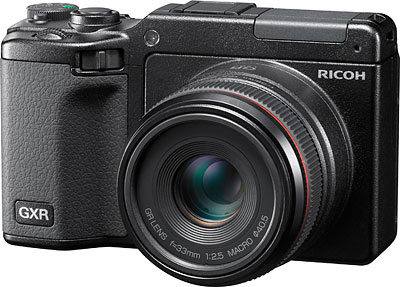
DE: This is actually more of a specific product question
relating to Ricoh. The electronic viewfinder has become a really popular
feature in cameras like Sony’s NEX-6 and 7 and the Olympus E-M5. Can we
expect to see Ricoh GXR bodies at some point with built-in EVFs?
JC: I’m not sure about built-in. We have the accessory EVF, but I’m not sure about an actual built-in.
DE: Can we expect to see AF systems with more AF points and more or expanded cross type sensors?
GT: I have some information from our engineering team.
Currently, there are 11 AF points in our products, and they’re thinking
that’s not enough for the current market, so they’re looking at adding
more.
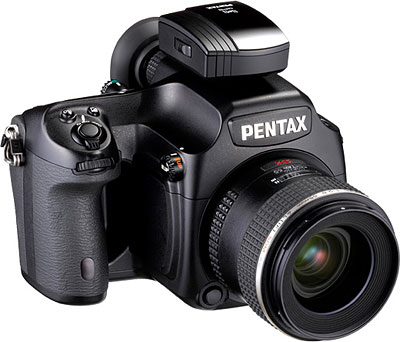
DE: Turning for the moment to medium format, another reader
question, the 645D was released in December of 2010. What sort of need
do you see to refresh offerings in that line up and can you talk
generally about both the near term and the longer term plans for that
line?
JC: Not specifics, but right now we’re focusing on
expanding the lens line-up because, while you can use the older film
lenses, they’re not currently available for distribution by us. So I
think that’s where we need to go first is expand the line up. So now
we’re up to 3 lenses--the 55mm f/2.8, the 25mm f/4, and the 90mm f/2.8.
But I think that that type of camera, just by the nature of the product,
the price, everything has to have a longer life cycle.
DE: That’s my next question, specifically relative to the
lenses. On your site, you show a very complete lineup of 645-compatible
lenses and most of them aren’t available currently. Have there been any
plans to renew production on some of those FA models as a way of filling
out the line? You have a lot of great lenses there.
GT: I can’t say what kind of products we’re now
developing but I can clearly say we launched the 90mm macro at
Photokina, and we’d like to continue to analyze the lineup to satisfy
customer demands.
We are receiving many suggestions from the users, they’d like to use
live view on the 645D, that kind of thing. As you mentioned already, the
645D was launched in 2010 so we need some enhancements or more
developments for future models.
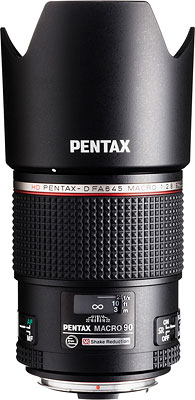
DE: Relative to your expectations, how has the 645D been doing?
JC: It did very well at the start and then it slowed
down a little bit. The existing lens owners bought into the system and
then the fact that we initially had only the 55mm lens available slowed
things down. While it was a good start, it didn’t really speak to the
professional market. So now that we’ve added the 25mm and we’ve added
the 90mm, we’ve got the wide angle for the landscape, we’ve got the 90mm
for the more portrait level, we have a more complete system to offer so
we expect it to come back up. Plus we just recently lowered the price
so that obviously should have an impact.
It’s now at $8,795 in the US. At that price you can buy the body and
all three lenses for about the price you’re paying for a body from one
of the other medium format manufacturers. So you can have a fairly
robust system for the price of just the body from anywhere else.
DE: Can you tell us anything about future plans for flashes?
GT: We understand the necessity to launch a new
product. Now with technologies like LEDs coming on to the market we are
looking at what kind of technology is acceptable for the future product.
We are still thinking about our next flashes.
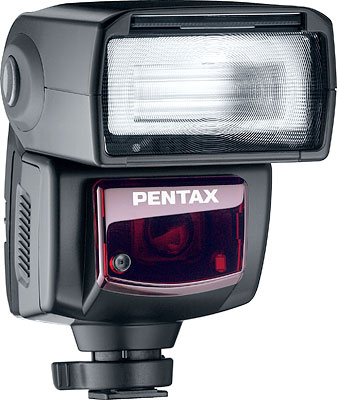
DE: That’s very interesting that you said that this is a point
in time when it really makes sense to look at just what technology you
should use. I hadn’t really considered that to think that it applies to
flashes.
GT: It used to be that only the Xenon is available for the flashes but the technologies are different now today.
JC: We look at the power consumption and everything. It pulls up a lot of possibilities.
DE: Also in size because with the xenon, you have to have a big
storage capacitor and you have to charge it up. LED could be very, very
compact and very energy-efficient.
GT: Our camera bodies are relatively small compared to the competitors, so we’re looking at developing small flashes as well.
DE: Jumping to lenses, to the DA series, a reader asks, “So
we’ve seen prime lenses become very popular on mirrorless cameras for
their street photography appeal. Do you have any plans to produce more
pancake primes like the DA limited offerings from a few years back?”
JC: The DA Limited line is--besides the
telephotos--it’s pretty complete. I mean, you have the 15mm, you have
the 21mm, you have the 35mm macro, the 40mm, the 70mm. So there’s a lot
to it right now. The only hole there is maybe a telephoto. But then you
look at our 100mm macro--while it’s not considered a limited lens, it
has the build quality.
DE: At IR, we’re big fans of Pentax SLRs for their unique mix
of features. You’ve got great image quality for APS-C. You have strong
lenses. You have weather proofing at lower price points and a small form
factor for full-featured SLRs. It looks like the K-5 II really extends
those advantages. But how do you get the message out to people about
your unique features? Are there particular applications or user
communities that you think you could target your messaging to? And what
other features do you think could help you compete with some of the
bigger names?
JC: It’s a difficult question because that’s the Holy
Grail – how do we get the message out to people. And we’re doing it in
the US somewhat by advertising. We just started a campaign on the K30 to
really talk about the weather sealing and that commonality between our
K30, our WG2 and our binocular product. The K-5 II has the weather
sealing. The 645 has the weather sealing. That’s a simple message we can
talk to customers about, whether we get that out to social networks,
through forums, through different avenues. We’re constantly looking for
ways to get that story out.
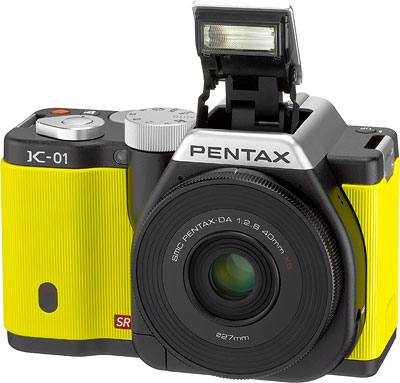
DE: With the strong APS-C size mirrorless offerings from Sony,
Samsung, and Canon and your own K-01, where will SLRs continue to offer
advantages. What’s the role for the SLR as we go forward?
JC: I think it has to do with shooting style. I think
there’s a fairly large group of photographers who are used to shooting a
certain way using a pentaprism viewfinder, taking advantage of that
100% field of view. The sort of advantage that I don’t think electronic
viewfinders offer now. A lot of those folks aren’t going to use an LCD
panel; but there’s definitely a customer for that as well. So I think
there’ll be a place for both of them. It depends on what’s next for the
mirrorless cameras.
I look at all different kinds of cameras and I’ve been a photographer
for 20 years myself. I have trouble using an electronic viewfinder. It’s
just not the same shooting experience and I think there are probably a
lot of people who have that same feeling and like a certain style of
photography versus another.
GT: We have heard the voice of some users, they say,
“Please continue the DSLR range” because they try to use EVF on a
competitor’s model but they don’t like it. They don’t think much of
electronic viewfinders, but they are more comfortable with conventional
mirror or prism viewfinders.
JC: As an analogy, some people can use an iPad, for
example, as an e-reader type device. Some people will continue to use an
e-ink type of device. Personally, I can’t use an iPad to read something
for an extended amount of time where I can pull up my Nook and read for
a couple of hours and it doesn’t bother my eyes. I think you kind of
almost have that similar kind of thing with the EVF versus an optical
viewfinder.
DE: Then you have the guys like me who still like books! I
guess that probably equates to going back to film or something. (laughs)
A big trend of Photokina 2012 seems to be “Full-frame goes
mainstream.” We’ve seen Nikon, Sony, and Canon have all announced full
frame cameras at lower price points. At Pentax, you have the K-5’s low
light capabilities and you already have a medium format offering. And
years ago, you showed one of the first full-frame SLRs that didn’t
actually make it out into the market. Where do you see the role for
full-frame generally and then in particular with respect to Pentax?
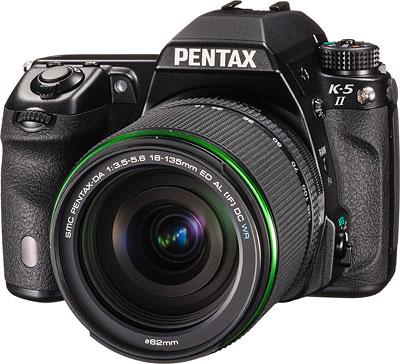
JC: It’s a very difficult question. Everybody is
asking us about how Pentax is approaching full frame products. As
always, we’re saying that we’re continuing to develop full frame
technologies. We have also found some issues and challenges, but we
continue to develop it.
We also believe the APS-C sensor has a lot of future potential. APS-C
used to have noise problems, and so on. But with the evolution in
technology, for example, the K-5 has an available ISO of 51,200.
So as of today, we will continue focusing on the APS-C cameras. It
depends on the user demands, also the market situation. We will study
continue to study the market.
JC: It’s a big commitment because while it’s not a
different mount, you have to create lenses for that, because all of our
current lenses, except for three Limiteds, are designed for the APS-C
sensor. We have the Q mount that we’re dedicated to. We have the K mount
that we’re dedicated to with the APS-C sensor, and we have the 645D. So
we have a lot going on already.
GT: And also, the medium format sensor has a lot of
potential. It used to be that 40 megapixels was a lot, but now Nikon’s
D800 has 36 megapixels. So if we launched a future 645D product, it
might need, I don’t know, 60 or even 80 megapixels.
And also we understand that full-frame has disadvantages. The body is
bigger, heaver, more expensive. There are disadvantages to full-frame as
well.
DE: Speaking of the lenses, this was another reader question:
There are rumors that many of your APS-C lenses might actually have full
frame circles but they’re not advertised as such. Can you shed some
light on that?
JC: All the tests I’ve seen, if you put those lenses
on a film body, you get vignetting. So they’re bigger than if it were
just an APS-C without shake reduction, but that added image circle is
just to accommodate the shake reduction, it doesn’t accommodate
full-frame.
DE: You’re the only company offering two different mirrorless
camera systems. How are the Q series and the K-01 buyers different from
each other?
JC: Speaking for the US market, the K-01, it’s a great
imaging device. I think a lot of people, a lot of photographers,
traditional photographers, look at the design and overlook that fact
because it’s a great sensor. It does great stills. It does great video.
We went a non-traditional route with the design. Because of that, it was
very well accepted in the design community. Mark Newson--while many
traditional photographers don’t know that name, there’s a large part of
the population that does recognize that name and that’s the lowest-cost
Mark Newson product you can buy.
I don’t think he’s as popular in the US as he is in other parts of the
world, but you know, I just saw a jacket he designed that costs as much
or more than the K-01 and it’s just a jacket. It’s had an impact in that
community. And videographers are starting to recognize the K-01 is a
pretty capable tool for that type of work.
The Q is a different challenge because unless you see it in person and
hold it, a lot of people don’t realize how small it really is. But at
the same time, you have pretty much all the controls of a traditional
DSLR camera, from aperture control to DNG RAW capture to video capture.
It does offer a lot.
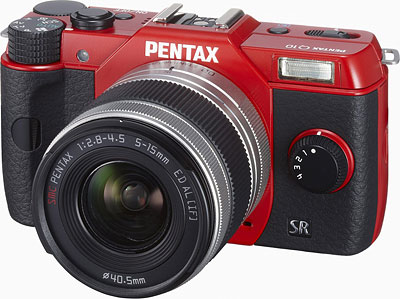
DE: So the challenge there is really making people understand just how small it is.
JC: And because of its size, it complements a DSLR.
It’s what you carry when you need better quality than your smartphone’s
going to offer, but you don’t want to carry a DSLR. Because smartphones
are convenient. They have connectivity that’s always on. But you’re
still limited to a smartphone image that won’t hold up to enlargement.
We’ve printed 13 x 19 images out of the Q that just looked beautiful.
You couldn’t tell them from an image with a larger camera.
DE: Is there any gender preference for the Q?
JC: Actually, we’ve seen a lot of female buyers for
the Q and we see that evidence in the colors that we’re selling. We’re
selling more white than we are of the black. So it definitely appeals to
the female market. I don’t want to say it’s a fashion statement but to a
certain degree, it is. It’s small. It’s stylish. It kind of has a retro
look to it.
DE: What gives you the greatest sense of excitement about
Photokina this year, whether it’s the product or a trend or something
you see?
JC: For Pentax, it’s the fact that our booth is
branded Pentax and Ricoh. We are one company. It’s not two companies,
it’s one company. And Ricoh is truly an imaging company from capture to
print. And you see some of that displayed in the booth. Obviously, with
the cameras, there’s a technology display that we have of some
360-degree capture technology, a twin-lens spherical capture. And then
there’s output. We have a wide format printer that offers exceptional
print quality. So I think, for the people who have been with Pentax for a
while, we’re very excited because Ricoh really wants to make Pentax
successful, to make cameras that are some of the best out there. So I
think we’re all excited about the combining of the two companies.
DE: Great. Well, a pleasure as always. Thanks very much for taking time in the middle of the busy show.
GT: Thank you very much.
JC: Thank you. Take care.
Q&A with Pentax’s John Carlson and Genichiro Takaoka: Is full-frame coming, and what’s next for medium format?
by Dave Etchells

John Carlson, Senior Manager of Sales and Marketing, Pentax Ricoh Imaging Americas Corp.
During the Photokina show, Dave Etchells sat down with Pentax
representatives from both the American and European continents to talk
about future directions for the company's cameras. Topics for discussion
included the medium-format 645D digital SLR, some of the technical
issues surrounding a future full-frame camera, and how the company can
best get its message across to photographers.
Representing Pentax in the Americas was John Carlson, Senior
Manager of Sales and Marketing at Pentax Ricoh Imaging Americas Corp.
From the European branch of Pentax was Genichiro Takaoka of the Europe
Team, Global Sales Support Group, System Camera Planning Team, Product
Planning Group, Marketing Department, Pentax Ricoh Imaging Co., Ltd.
Dave Etchells/Imaging Resource: We’re very happy to see Ricoh
decide to give Pentax an important role, and to see Ricoh making big
investments in Pentax. Can you tell us anything about the potential
collaborations or sharing new features and technology that you’re most
excited about between the firms?
Genichiro Takaoka/Pentax Ricoh Imaging Co., Ltd.: Yes,
we are just joining the Ricoh engineers from the first of April to
collaborate on some of the projects. We’ve just started.
John Carlson/Pentax Ricoh Imaging Americas Corp: We really haven’t seen the impact of having the two groups together, so maybe in the CES timeframe or later.
GT: We can’t exactly say when and what kind of products are going on currently, but you will see them in the future.
JC: For us, a lot of the changes so far have been more management changes and not necessarily product changes.
DE: How is the Ricoh relationship different from the one you had with Hoya?
JC: They are definitely much more involved and want a
lot more growth from the camera division. Ricoh didn’t have a consumer
business side besides their digital cameras, which is relatively small
in the US. So this really represents an opportunity to get into the
consumer market. And they’re really--from capture to output--an imaging
company, so having this consumer side of things helps the overall brand.
So we really think it’s going to be a positive thing.

DE: This is actually more of a specific product question
relating to Ricoh. The electronic viewfinder has become a really popular
feature in cameras like Sony’s NEX-6 and 7 and the Olympus E-M5. Can we
expect to see Ricoh GXR bodies at some point with built-in EVFs?
JC: I’m not sure about built-in. We have the accessory EVF, but I’m not sure about an actual built-in.
DE: Can we expect to see AF systems with more AF points and more or expanded cross type sensors?
GT: I have some information from our engineering team.
Currently, there are 11 AF points in our products, and they’re thinking
that’s not enough for the current market, so they’re looking at adding
more.

DE: Turning for the moment to medium format, another reader
question, the 645D was released in December of 2010. What sort of need
do you see to refresh offerings in that line up and can you talk
generally about both the near term and the longer term plans for that
line?
JC: Not specifics, but right now we’re focusing on
expanding the lens line-up because, while you can use the older film
lenses, they’re not currently available for distribution by us. So I
think that’s where we need to go first is expand the line up. So now
we’re up to 3 lenses--the 55mm f/2.8, the 25mm f/4, and the 90mm f/2.8.
But I think that that type of camera, just by the nature of the product,
the price, everything has to have a longer life cycle.
DE: That’s my next question, specifically relative to the
lenses. On your site, you show a very complete lineup of 645-compatible
lenses and most of them aren’t available currently. Have there been any
plans to renew production on some of those FA models as a way of filling
out the line? You have a lot of great lenses there.
GT: I can’t say what kind of products we’re now
developing but I can clearly say we launched the 90mm macro at
Photokina, and we’d like to continue to analyze the lineup to satisfy
customer demands.
We are receiving many suggestions from the users, they’d like to use
live view on the 645D, that kind of thing. As you mentioned already, the
645D was launched in 2010 so we need some enhancements or more
developments for future models.

DE: Relative to your expectations, how has the 645D been doing?
JC: It did very well at the start and then it slowed
down a little bit. The existing lens owners bought into the system and
then the fact that we initially had only the 55mm lens available slowed
things down. While it was a good start, it didn’t really speak to the
professional market. So now that we’ve added the 25mm and we’ve added
the 90mm, we’ve got the wide angle for the landscape, we’ve got the 90mm
for the more portrait level, we have a more complete system to offer so
we expect it to come back up. Plus we just recently lowered the price
so that obviously should have an impact.
It’s now at $8,795 in the US. At that price you can buy the body and
all three lenses for about the price you’re paying for a body from one
of the other medium format manufacturers. So you can have a fairly
robust system for the price of just the body from anywhere else.
DE: Can you tell us anything about future plans for flashes?
GT: We understand the necessity to launch a new
product. Now with technologies like LEDs coming on to the market we are
looking at what kind of technology is acceptable for the future product.
We are still thinking about our next flashes.

DE: That’s very interesting that you said that this is a point
in time when it really makes sense to look at just what technology you
should use. I hadn’t really considered that to think that it applies to
flashes.
GT: It used to be that only the Xenon is available for the flashes but the technologies are different now today.
JC: We look at the power consumption and everything. It pulls up a lot of possibilities.
DE: Also in size because with the xenon, you have to have a big
storage capacitor and you have to charge it up. LED could be very, very
compact and very energy-efficient.
GT: Our camera bodies are relatively small compared to the competitors, so we’re looking at developing small flashes as well.
DE: Jumping to lenses, to the DA series, a reader asks, “So
we’ve seen prime lenses become very popular on mirrorless cameras for
their street photography appeal. Do you have any plans to produce more
pancake primes like the DA limited offerings from a few years back?”
JC: The DA Limited line is--besides the
telephotos--it’s pretty complete. I mean, you have the 15mm, you have
the 21mm, you have the 35mm macro, the 40mm, the 70mm. So there’s a lot
to it right now. The only hole there is maybe a telephoto. But then you
look at our 100mm macro--while it’s not considered a limited lens, it
has the build quality.
DE: At IR, we’re big fans of Pentax SLRs for their unique mix
of features. You’ve got great image quality for APS-C. You have strong
lenses. You have weather proofing at lower price points and a small form
factor for full-featured SLRs. It looks like the K-5 II really extends
those advantages. But how do you get the message out to people about
your unique features? Are there particular applications or user
communities that you think you could target your messaging to? And what
other features do you think could help you compete with some of the
bigger names?
JC: It’s a difficult question because that’s the Holy
Grail – how do we get the message out to people. And we’re doing it in
the US somewhat by advertising. We just started a campaign on the K30 to
really talk about the weather sealing and that commonality between our
K30, our WG2 and our binocular product. The K-5 II has the weather
sealing. The 645 has the weather sealing. That’s a simple message we can
talk to customers about, whether we get that out to social networks,
through forums, through different avenues. We’re constantly looking for
ways to get that story out.

DE: With the strong APS-C size mirrorless offerings from Sony,
Samsung, and Canon and your own K-01, where will SLRs continue to offer
advantages. What’s the role for the SLR as we go forward?
JC: I think it has to do with shooting style. I think
there’s a fairly large group of photographers who are used to shooting a
certain way using a pentaprism viewfinder, taking advantage of that
100% field of view. The sort of advantage that I don’t think electronic
viewfinders offer now. A lot of those folks aren’t going to use an LCD
panel; but there’s definitely a customer for that as well. So I think
there’ll be a place for both of them. It depends on what’s next for the
mirrorless cameras.
I look at all different kinds of cameras and I’ve been a photographer
for 20 years myself. I have trouble using an electronic viewfinder. It’s
just not the same shooting experience and I think there are probably a
lot of people who have that same feeling and like a certain style of
photography versus another.
GT: We have heard the voice of some users, they say,
“Please continue the DSLR range” because they try to use EVF on a
competitor’s model but they don’t like it. They don’t think much of
electronic viewfinders, but they are more comfortable with conventional
mirror or prism viewfinders.
JC: As an analogy, some people can use an iPad, for
example, as an e-reader type device. Some people will continue to use an
e-ink type of device. Personally, I can’t use an iPad to read something
for an extended amount of time where I can pull up my Nook and read for
a couple of hours and it doesn’t bother my eyes. I think you kind of
almost have that similar kind of thing with the EVF versus an optical
viewfinder.
DE: Then you have the guys like me who still like books! I
guess that probably equates to going back to film or something. (laughs)
A big trend of Photokina 2012 seems to be “Full-frame goes
mainstream.” We’ve seen Nikon, Sony, and Canon have all announced full
frame cameras at lower price points. At Pentax, you have the K-5’s low
light capabilities and you already have a medium format offering. And
years ago, you showed one of the first full-frame SLRs that didn’t
actually make it out into the market. Where do you see the role for
full-frame generally and then in particular with respect to Pentax?

JC: It’s a very difficult question. Everybody is
asking us about how Pentax is approaching full frame products. As
always, we’re saying that we’re continuing to develop full frame
technologies. We have also found some issues and challenges, but we
continue to develop it.
We also believe the APS-C sensor has a lot of future potential. APS-C
used to have noise problems, and so on. But with the evolution in
technology, for example, the K-5 has an available ISO of 51,200.
So as of today, we will continue focusing on the APS-C cameras. It
depends on the user demands, also the market situation. We will study
continue to study the market.
JC: It’s a big commitment because while it’s not a
different mount, you have to create lenses for that, because all of our
current lenses, except for three Limiteds, are designed for the APS-C
sensor. We have the Q mount that we’re dedicated to. We have the K mount
that we’re dedicated to with the APS-C sensor, and we have the 645D. So
we have a lot going on already.
GT: And also, the medium format sensor has a lot of
potential. It used to be that 40 megapixels was a lot, but now Nikon’s
D800 has 36 megapixels. So if we launched a future 645D product, it
might need, I don’t know, 60 or even 80 megapixels.
And also we understand that full-frame has disadvantages. The body is
bigger, heaver, more expensive. There are disadvantages to full-frame as
well.
DE: Speaking of the lenses, this was another reader question:
There are rumors that many of your APS-C lenses might actually have full
frame circles but they’re not advertised as such. Can you shed some
light on that?
JC: All the tests I’ve seen, if you put those lenses
on a film body, you get vignetting. So they’re bigger than if it were
just an APS-C without shake reduction, but that added image circle is
just to accommodate the shake reduction, it doesn’t accommodate
full-frame.
DE: You’re the only company offering two different mirrorless
camera systems. How are the Q series and the K-01 buyers different from
each other?
JC: Speaking for the US market, the K-01, it’s a great
imaging device. I think a lot of people, a lot of photographers,
traditional photographers, look at the design and overlook that fact
because it’s a great sensor. It does great stills. It does great video.
We went a non-traditional route with the design. Because of that, it was
very well accepted in the design community. Mark Newson--while many
traditional photographers don’t know that name, there’s a large part of
the population that does recognize that name and that’s the lowest-cost
Mark Newson product you can buy.
I don’t think he’s as popular in the US as he is in other parts of the
world, but you know, I just saw a jacket he designed that costs as much
or more than the K-01 and it’s just a jacket. It’s had an impact in that
community. And videographers are starting to recognize the K-01 is a
pretty capable tool for that type of work.
The Q is a different challenge because unless you see it in person and
hold it, a lot of people don’t realize how small it really is. But at
the same time, you have pretty much all the controls of a traditional
DSLR camera, from aperture control to DNG RAW capture to video capture.
It does offer a lot.

DE: So the challenge there is really making people understand just how small it is.
JC: And because of its size, it complements a DSLR.
It’s what you carry when you need better quality than your smartphone’s
going to offer, but you don’t want to carry a DSLR. Because smartphones
are convenient. They have connectivity that’s always on. But you’re
still limited to a smartphone image that won’t hold up to enlargement.
We’ve printed 13 x 19 images out of the Q that just looked beautiful.
You couldn’t tell them from an image with a larger camera.
DE: Is there any gender preference for the Q?
JC: Actually, we’ve seen a lot of female buyers for
the Q and we see that evidence in the colors that we’re selling. We’re
selling more white than we are of the black. So it definitely appeals to
the female market. I don’t want to say it’s a fashion statement but to a
certain degree, it is. It’s small. It’s stylish. It kind of has a retro
look to it.
DE: What gives you the greatest sense of excitement about
Photokina this year, whether it’s the product or a trend or something
you see?
JC: For Pentax, it’s the fact that our booth is
branded Pentax and Ricoh. We are one company. It’s not two companies,
it’s one company. And Ricoh is truly an imaging company from capture to
print. And you see some of that displayed in the booth. Obviously, with
the cameras, there’s a technology display that we have of some
360-degree capture technology, a twin-lens spherical capture. And then
there’s output. We have a wide format printer that offers exceptional
print quality. So I think, for the people who have been with Pentax for a
while, we’re very excited because Ricoh really wants to make Pentax
successful, to make cameras that are some of the best out there. So I
think we’re all excited about the combining of the two companies.
DE: Great. Well, a pleasure as always. Thanks very much for taking time in the middle of the busy show.
GT: Thank you very much.
JC: Thank you. Take care.
 Re: Photokina 2012 : Interview de Pentax Ricoh by clover
Re: Photokina 2012 : Interview de Pentax Ricoh by clover
Eh ouai, avant de penser à un super boitier FF faudrait avoir des optiques compatibles et on sort pas en 1 année 10 optiques compatibles FF... Donc le 4x36 chez pentax c'est pas avant 6 ans !

qqundejm- Apprenti Tchatcheur

-
 Nombre de messages : 189
Nombre de messages : 189
Age : 37
Localisation : Annecy-Le-Vieux
Date d'inscription : 19/08/2009
 Re: Photokina 2012 : Interview de Pentax Ricoh by clover
Re: Photokina 2012 : Interview de Pentax Ricoh by clover
Merci Clover pour cette initiative et pour nous faire partager cette interview!
Par contre cela ne nous apprend finalement pas grand chose, des surprises en 2013, il aurait été difficile de dire autre chose. Et dans l'interview d'IR (merci serdeber) on en apprend pas beaucoup plus non plus...
Par contre cela ne nous apprend finalement pas grand chose, des surprises en 2013, il aurait été difficile de dire autre chose. Et dans l'interview d'IR (merci serdeber) on en apprend pas beaucoup plus non plus...

lilidje- Tchatcheur Suprème

-
 Nombre de messages : 997
Nombre de messages : 997
Age : 44
Localisation : Ile de France
Date d'inscription : 10/03/2009
 Re: Photokina 2012 : Interview de Pentax Ricoh by clover
Re: Photokina 2012 : Interview de Pentax Ricoh by clover
eisenheim a écrit:
Enfin on verra, l'avantage du futur NEX FF et qu'on pourra mettre tous nous cailloux Pentax en manuel sans devoir les bricoler comme sur un eos 5D. On pourra toujours attendre 10 ans pour qu'il ressuscite la monture et le format FF chez Pentax mdr. En attendant, il est déjà super plaisant d'utiliser les limited DA sur un nex 5N en focus peaking.
oui enfin pas que pentax d'ailleurs, j'ai l'impression que sony a une carte à jouer décisive dans la guerre commerciale du numérique. Je sais pas si vous avez jeter un coup d'oeil dans un alpha 77, et bien mon avis est que ça cartonne grave.
Un nex FF prochainement sur le marché risque de faire l'effet d'une bombe. Par ailleursn on peut y adapter n'importe quoi! canon FD, canon eos, pentax K, M42, leica... bref pour ceux qui aiment adapter c'est francehement un gros plus !
 Re: Photokina 2012 : Interview de Pentax Ricoh by clover
Re: Photokina 2012 : Interview de Pentax Ricoh by clover
Surfing a écrit:
De toutes façons, soit on prend ce qui existe dans une marque, soit on change de marque,
Troisième solution que j'ai adopté, rester avec un boitier pentax aps-c pour la philosophie de la marque et un FF canon pour y adapter du pentax justement et m42.
Surfing a écrit:
Vous pensez que vous ferez de meilleures photos en 24x36 ? faux pour la plupart.
+1, cela ne change pas fondammentalement les choses, ceux qui font de la M... avec un aps-c feront exactement la même chose avec du FF...
.
Surfing a écrit:
Vous avez les moyens financiers de vos ambitions ou de votre rêve ? Et bien allez-y, et sincèrement tous mes voeux vous accompagnent.
j'ai dis ça ya pas longtemps ! apres si c ets pour avoir du 24x36, je me tue à le dire, un 5D premiere génération en a encore dans le ventre à revendre. Surtout qu'entre nous, beaucoup ici, regarde leur photo sur des écrans 15 pouces et ne font pas d'agrandissement!
 Re: Photokina 2012 : Interview de Pentax Ricoh by clover
Re: Photokina 2012 : Interview de Pentax Ricoh by clover
je me tue à dire ça depuis au moins dix à douze posts...

Val.Ou- Dieu Tchatcheur

-
 Nombre de messages : 4125
Nombre de messages : 4125
Age : 77
Localisation : Ile de France - Massy
Date d'inscription : 22/01/2009
 Re: Photokina 2012 : Interview de Pentax Ricoh by clover
Re: Photokina 2012 : Interview de Pentax Ricoh by clover
Val.Ou a écrit:je me tue à dire ça depuis au moins dix à douze posts...
je sais bien Valia, je partage ton avis avant même d'avoir le 5D, pour preuve l'ensemble des sujets/APS-c où j'ai posté.
Pour beaucoup, le 24x36 est un fantasme, et même si ce n'est pas à l'ordre du jour du pentax, je pense que lorsque l'on vient dans cette marque on cherche avant tout un bon rapport qualité prix innovation...
 Re: Photokina 2012 : Interview de Pentax Ricoh by clover
Re: Photokina 2012 : Interview de Pentax Ricoh by clover
Je pense effectivement qu'on vient pour un bon rapport qualité prix, pour les anciens objectifs auss.
Par ailleurs je pense que toute cette histoire de FF, c'est du marketing. pas que ce soit pas mieux dans l'absolu que APS-C, mais pourquoi 24x36? pourquoi pas 20x30 ou 26x39?
Quand l'on y pense, vu qu'on achètes plus de pellicules et que les objectifs sont incompatibles essentiellement entre différent systèmes, y'a pas trop de raison...
Sauf un super vieux standard, qui fait que historiquement on utilise ce format. Au point que le cinema a adopté le 72mm... 2 pélicules 24x36 cote à cote quoi...
Mais quelqu'un qui à 20 ou 30 ans et qui achetes sont premier reflex, le 24x36 ça signifie rien pour lui. L'argentique non plus d'ailleurs... Il voit ça un peu comme la télé noir et blanc ou les machines de pascal comme calculatrice.
En fait non... il sait même pas ce que c'est une machine de pascal
Ce qui va compter donc pour lui, c'est la qualité d'un coté, et un prix contenu de l'autre. Surtout que souvent quand l'on est jeune, l'argent n'est pas infini non plus.
Comme par hazard, tout le monde se fout du MF... oui c'est très cher, mais il n'y a pas que ça, il n'y a pas le même mythe. Mais je pense que Pentax ne la joue pas si mal en restant qualitatif sur APS-C, c'est quand même l'essentiel des ventes en reflex.
Par ailleurs je pense que toute cette histoire de FF, c'est du marketing. pas que ce soit pas mieux dans l'absolu que APS-C, mais pourquoi 24x36? pourquoi pas 20x30 ou 26x39?
Quand l'on y pense, vu qu'on achètes plus de pellicules et que les objectifs sont incompatibles essentiellement entre différent systèmes, y'a pas trop de raison...
Sauf un super vieux standard, qui fait que historiquement on utilise ce format. Au point que le cinema a adopté le 72mm... 2 pélicules 24x36 cote à cote quoi...
Mais quelqu'un qui à 20 ou 30 ans et qui achetes sont premier reflex, le 24x36 ça signifie rien pour lui. L'argentique non plus d'ailleurs... Il voit ça un peu comme la télé noir et blanc ou les machines de pascal comme calculatrice.
En fait non... il sait même pas ce que c'est une machine de pascal
Ce qui va compter donc pour lui, c'est la qualité d'un coté, et un prix contenu de l'autre. Surtout que souvent quand l'on est jeune, l'argent n'est pas infini non plus.
Comme par hazard, tout le monde se fout du MF... oui c'est très cher, mais il n'y a pas que ça, il n'y a pas le même mythe. Mais je pense que Pentax ne la joue pas si mal en restant qualitatif sur APS-C, c'est quand même l'essentiel des ventes en reflex.
Invité- Invité
 Re: Photokina 2012 : Interview de Pentax Ricoh by clover
Re: Photokina 2012 : Interview de Pentax Ricoh by clover
rizard a écrit:Val.Ou a écrit:je me tue à dire ça depuis au moins dix à douze posts...
je sais bien Valia, je partage ton avis avant même d'avoir le 5D, pour preuve l'ensemble des sujets/APS-c où j'ai posté.
Pour beaucoup, le 24x36 est un fantasme, et même si ce n'est pas à l'ordre du jour du pentax, je pense que lorsque l'on vient dans cette marque on cherche avant tout un bon rapport qualité prix innovation...
C'est ce qui rend la situation ambigue puisque commercialement, le 24x36 est potentiellement voir probablement la gamme amateur expert des prochaines années, avec défrichement un peu difficile ( le Sony alpha850 n'a pas été un franc succès ) mais sa "médiatisation" et son montée qualitative en haute sensibilité a rendu acceptable le prix du ticket d'entrée actuel.
En cela , Pentax n'a pas complètement tort de ne pas proposer encore un DSLR FF tant qu'il n'y a pas une possibilité de produire un boitier à moins de 1500€, ce qui représente la cible de Pentax. Nikon avait visiblement ciblé cette gamme de prix, mais n'a pas pu le faire, du moins, pas dans l'immédiat ( évolution du strret price d'ici 2 ans de temps ?)
Il y a cependant la problématique de ceux qui ne veulent pas attendre sans élément concret et du coup, seul le switch ( total ou partiel ) est la réponse. Cela correspond à la possibilité d'investir dans un produit qui correspond à la demande à un temps t par rapport au budget alloué.
Maintenant, j'ai quand même l'impression que toutes les marques se sont mises aux mirrorless par rapport au marché, et que le FF pourrait bien être le segment suivant qui sera vendeur pour les amateurs experts, par contre, cela représente un peu une niche et il y a déjà pas mal d'offre...
En gros, Pentax ne s'en sortira avec un FF qu'en refaisant le coup du K10D : quasi même fiche technique que le Nikon D200 à l'époque et 20% moins cher en moyenne...( EDIT : c'est aussi un peu le même coup que Pentax a fait avec le 645D...)
D'ici là, "attendre" reste la solution la plus "économique"...pour moi...

clover- Dieu Tchatcheur

-
 Nombre de messages : 2009
Nombre de messages : 2009
Age : 50
Localisation : Earth
Date d'inscription : 28/05/2007
 Re: Photokina 2012 : Interview de Pentax Ricoh by clover
Re: Photokina 2012 : Interview de Pentax Ricoh by clover
clover a écrit:C'est ce qui rend la situation ambigue puisque commercialement, le 24x36 est potentiellement voir probablement la gamme amateur expert des prochaines années, avec défrichement un peu difficile ( le Sony alpha850 n'a pas été un franc succès ) mais sa "médiatisation" et son montée qualitative en haute sensibilité a rendu acceptable le prix du ticket d'entrée actuel.
la médiatisation du FF c'est relatif, perso je vois largement plus de pubs pour des reflex entrée de gamme ou des compacts que pour des FF. Après y'a l'image "pro" véhiculée....
J'espère que les gens qui passent au FF ne le font pas que pour la montée en iso!!
Je ne sais plus où j'avais lu ça mais je crois bien que chez canon les ventes de FF représentaient 1 reflex sur 10 (ça va certainement changer avec l'élargissement de leur gamme)
clover a écrit:Nikon avait visiblement ciblé cette gamme de prix, mais n'a pas pu le faire, du moins, pas dans l'immédiat ( évolution du strret price d'ici 2 ans de temps ?)
je ne pense pas que nikon ait prétendu vouloir faire un FF à moins de 1500e, ce sont plutôt les internautes qui en rêvaient!!

lilidje- Tchatcheur Suprème

-
 Nombre de messages : 997
Nombre de messages : 997
Age : 44
Localisation : Ile de France
Date d'inscription : 10/03/2009
 Re: Photokina 2012 : Interview de Pentax Ricoh by clover
Re: Photokina 2012 : Interview de Pentax Ricoh by clover
Pour la médiatisation, cela concerne pour l'instant les amateurs experts, et ça marche au vu du raffût induit par l'absence de FF présenté par Pentax à la Kina 2012.
Pour Nikon, une source industrielle avait fuitée, pas qu'un rêve d'internautes.
Et puis, suffit de voir que son prix, évoluant sous 1an avec potentiellement 20% de chute de prix voir plus...
Après, il reste les derniers Nikon D700, pas dit qu'il ne partiront pas à 1500€ neuf...
Pour Nikon, une source industrielle avait fuitée, pas qu'un rêve d'internautes.
Et puis, suffit de voir que son prix, évoluant sous 1an avec potentiellement 20% de chute de prix voir plus...
Après, il reste les derniers Nikon D700, pas dit qu'il ne partiront pas à 1500€ neuf...

clover- Dieu Tchatcheur

-
 Nombre de messages : 2009
Nombre de messages : 2009
Age : 50
Localisation : Earth
Date d'inscription : 28/05/2007
Page 3 sur 3 •  1, 2, 3
1, 2, 3
 Sujets similaires
Sujets similaires» PENTAX RICOH IMAGING - communique presse 11/09/2012 -HD PENTAX-DA 560mm f/5,6 ED AW
» PENTAX RICOH IMAGING - communique presse 11/09/2012 - l’appellation « HD PENTAX »
» PENTAX RICOH IMAGING - communique de presse 11/09/2012 - PENTAX-DA 18-270mm f/3,5-6,3
» smc PENTAX-DA 50mm f/1.8 - Pentax Ricoh - Communiqué de presse du 22 mai 2012
» PENTAX RICOH IMAGING - communique presse 11/09/2012 - D-FA645 MACRO 90mm f/2,8 ED AW
» PENTAX RICOH IMAGING - communique presse 11/09/2012 - l’appellation « HD PENTAX »
» PENTAX RICOH IMAGING - communique de presse 11/09/2012 - PENTAX-DA 18-270mm f/3,5-6,3
» smc PENTAX-DA 50mm f/1.8 - Pentax Ricoh - Communiqué de presse du 22 mai 2012
» PENTAX RICOH IMAGING - communique presse 11/09/2012 - D-FA645 MACRO 90mm f/2,8 ED AW
Pentax K par K :: LES PETIT's + :: NEWS RELATIVES A LA PHOTO :: Logiciels, Optiques compatibles Pentax, Accessoires
Page 3 sur 3
Vos permissions sur ce forum :
Vous ne pouvez pas répondre aux sujets dans ce forum


